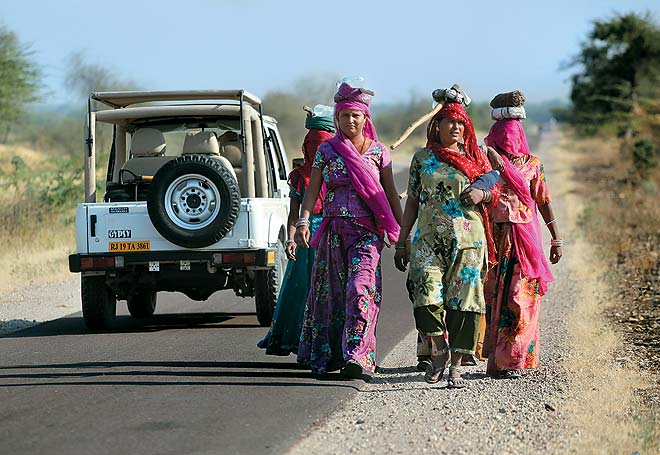 CAR
CAR
Few tourists decide to bring their own cars to India. It is possible only after obtaining a pass entitling to temporary import of the vehicle to India without paying the duty. Its absence would expose the visitor to very serious expenses.
Rentals
It is true that there are not many rental companies in India, but car rental is always possible in larger cities. Bud-get and Hertz rental companies are located in Delhi and Jaipur, among others.
State-owned travel agencies and – sometimes – hotel. The cost of this service compared to the prices, what you pay for renting a car (without a driver) in Poland, it is relatively low.
It is becoming more and more popular among tourists traveling in India to rent a car with a driver. For group travel, it is very cost effective, as the costs are then shared between several passengers. It is a very convenient means of transport, and it can be reached everywhere.
Renting a car for your own needs costs approx. 500 INR per night, if not exceeded 150 km per day; each additional kilometer traveled costs 4 INR. The price does not include fuel. Additionally, a pledge must be paid in the amount of 1000 INR, in case of any damage to the car. Even a minor scratch on the car body can be considered a serious fault.
Taxis
Almost every taxi driver will willingly agree to go with a tourist to explore the country, even if it would take several or several days. The easiest way is to just go to the taxi rank, find the right person and go on a journey.
A one-way taxi trip costs money 6 INR per kilometer, the way back by the same car only 3 INR. The price of the 4-day trip (ok. 200 km per day) will be 2400 INR. If someone is going to take a taxi to a place away from 200 km, and then come back after spending two days there, can make the entire journey in one taxi, because drivers are willing to wait for their passengers.
Road condition
Driving a car on Indian roads is not the most pleasant – often, they are crowded, narrow and full of potholes. As a result, a lot of time is wasted and a lot of gasoline is burned. Roadside assistance is sluggish, spare parts are missing, although there are many car repair shops along the roads. Traveling in less populated areas is slightly better, outside large cities, where there is much less traffic.
Road safety
He dies on Indian roads every day 155 people, which gives a year 56 000 victims – exceptionally high compared to the number of cars registered in this country. There are at least several reasons for such a high road fatality rate, the most obvious of which are heavy traffic and too many passengers in the vehicles. When a crowded bus goes out of the way, there is little chance, so that all may be saved. According to a report published by one of the Indian magazines, that the most common causes of accidents are brake failures and damage to the steering wheel (!).
Most of the victims are pedestrians hit by vehicles, whose drivers fled the scene of the accident. It is hardly surprising, for this is the only way to avoid lynching by angry mobs, who will not hesitate to attack the driver, even if he is innocent!
Jungle law applies on Indian roads, and not traffic regulations: the car has an advantage over pedestrians, and the larger vehicle over the smaller. No wonder then, that the most common perpetrators of accidents are truck drivers, who do not obey any traffic regulations; therefore it is best to give way to them. Usually these vehicles carry a lot of cargo, and their technical condition leaves much to be desired, although owners are required to pay tax on excess goods. Tell the truth, it is best to avoid lorry roads at all.
The theory of karma also explains a large number of accidents. According to her, the perpetrators of accidents are not cars, but human works in a previous incarnation, which designate such, and not a different fate of man. You can often see unlit cars or carts on the roads at night, and during the day, daring cyclists cause a lot of trouble, inattentive passers-by and of course – truck drivers. Driving at night, you also need to get used to it, that Hindus only use long lights, forgetting about the short ones, and in crowded streets they sound their horns all the time.
Tips for drivers
Left-hand traffic In theory, India has left-hand traffic, similar to Japan, Great Britain or Australia. In reality, however, most cars drive in the middle of the road, in order to avoid the potholes. Drivers of smaller vehicles should keep a larger distance from the road, especially trucks, if they want to avoid a collision.
Overtaking Indian drivers usually do not pay attention to the prohibition of overtaking on certain road sections, e.g. sharp turns or steep climbs. They are rarely stopped by an oncoming car. There is an unwritten law here, that drivers of smaller cars give way or slow down, when a larger vehicle overtakes them.
The horn is the most important component of a car in India. Broken brakes or bald tires are not an obstacle, however, no self-respecting Indian driver will get in the car, in which the horn does not work. Recent studies have shown, that the average driver has been using it since 10 do 20 times over a distance of just one kilometer, which means, that on a 100-kilometer route, it honks over 2000 times! Tourists intending to travel around India by car will soon find out for themselves, that it is used on average every 100 m, completely ignoring the prohibition signs.